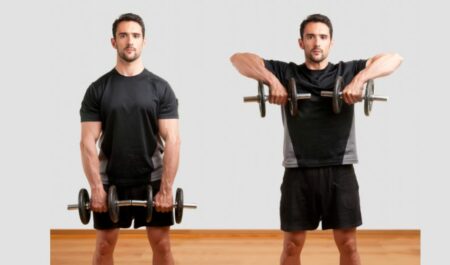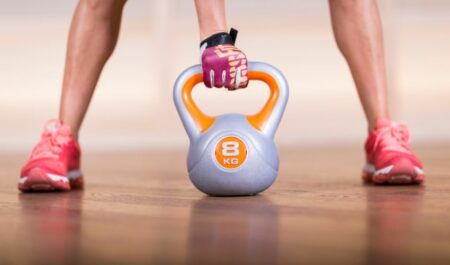The upright row is an excellent exercise to perform if you want to develop the strength in your shoulders and upper back. This exercise stimulates the deltoids, which wrap over your shoulder, as well as the trapezius, which spans from the upper to the middle of your back. In this article is going to discuss about, what is an upright row exercise with its benefits, common mistakes, alternatives and use of equipment.
This is widely regarded as one of the most effective exercises for building muscle in the back and shoulders. It also requires proper form, which is essential for achieving the best results and preventing damage, as this activity can be harmful to the shoulders. Bodybuilders are the most common people to execute this exercise, however it may also be seen in some boot camps and high-intensity interval training (HIIT) sessions.

Where Is The Value In That?
Because this is a pull exercise, you will be bringing the weight closer to you while working the muscles in your posterior chain, which are located on the back and sides of your body.
An effective exercise to improve strength in the shoulders and upper back, the upright row targets both of these muscle groups.
If you sit for most of the day, strengthening your posterior chain will be extremely useful to your ability to function normally during the day.
In spite of the fact that performing an upright row might provide a number of health benefits, there is a perception that the exercise can lead to injuries.
This does not mean that you should avoid this exercise; however, it does mean that maintaining proper form is more important than it has ever been.
During the movement, your hands are prevented from moving from their current posture, which results in your upper arm rotating inwardly within the shoulder, which could potentially pinch a tendon.
How Do You Do Upright Row Exercise?
Start off by completing three sets of ten to twelve repetitions each. Because increasing the weight before you have fully mastered 12 repetitions might raise the risk of injury, resist the urge to do so even if it may be tempting to do so.
You only need a barbell to perform an upright row, so you can do this exercise virtually anywhere. The only equipment required is your own bodyweight (or dumbbell or kettlebell).
How To get moving:
- Stand with your feet placed shoulder-width apart and your arms stretched in front of you while holding the barbell with an overhand grip. Your hold should be at a distance equal to that of a shoulder.
- You should start by lifting the dumbbell up, pulling through your elbows while keeping the weight close to your body as you go. Stop the movement when the barbell is at chest level and your elbows are at the same height as your shoulders. Maintain an upright position in your torso during the movement.
- Take a moment to rest at the peak, then make your way back down. Perform the necessary amount of repetitions until failure.
How Exactly Will You Incorporate This Into Your Daily Activities?
The addition of an upright row to a day dedicated to working the upper body can serve as a wonderful supplement to other varieties of rows, as well as lat pulldowns, chest presses, pushups, and a variety of other exercises.
Alternately, if you perform your workouts by alternating between pushes and pulls, try adding the upright row to one of your pull days for some added variety.
It is essential to perform a thorough warm-up before engaging in weightlifting no matter how or when you decide to incorporate an upright row into your regimen.
In order to prepare your body for activity, you should make sure you warm up with five to ten minutes of cardio at a low to medium intensity, followed by some dynamic stretching.
What Are The Most Common Mistakes That One Should Look Out For?
Although you shouldn’t let the prospect of including upright rows into your workout program intimidate you, there are a few common pitfalls that you should try to avoid making when performing this exercise.
Your Elbows Are At An Awkwardly High Angle.
Shoulder pain can be caused by injuring your shoulder by lifting your arms higher than parallel to the ground. Be careful to halt the movement when your elbows reach the height of your shoulders.
You Are Putting Too Much Weight On Your Lifts.
If your weight is too big, the movement will demand momentum, which will pull the focus away from the shoulders and put too much stress on them, or even worse, place them under unnecessary strain.
Pick a barbell or weight that will enable you to move at a pleasant, leisurely pace while maintaining control.
You Are Not Maintaining An Upright Torso Position.
It is critical that your torso remains upright so that you can keep the muscles in your core engaged. To get the most out of the exercise, you should focus on isolating your shoulders and upper back as much as possible.
Are There Any Additional Weights That You Can Use?
For upright rows, you have options other than just barbells to use. Additionally, you might use:
Use Dumbbells.
When you use dumbbells instead of a fixed bar, your hands have more freedom of movement, which means the internal rotation that might lead to injury is mitigated to a greater extent.
You should choose dumbbells that are slightly less than half the weight of the barbell you were using. For example, if you were using a 30-pound barbell, you should choose 12-pound dumbbells for each hand to begin with.
Use Kettlebells.

In a manner analogous to that of dumbbells, kettlebells permit a greater range of motion in the wrists and arms, and they are less likely to induce any internal rotation of the shoulder.
Again, instead of exercising with a barbell, choose to exercise with a kettlebell that is slightly less than half the weight of the barbell.
What Variations Are Available To You?
You can add some variety to the proceedings by attempting one of the many different variations on an upright row.
Cable Machine.
You can accomplish the same movement with your arms by using a cable machine equipped with either a straight bar or a revolving curl bar.
Creating a compound action by adding another movement to the upright row will offer you more bang for your buck in terms of the amount of muscle engagement you experience as a result of the exercise.
Pressing When In An Upright Row
To perform an overhead press, first pull the weight up into an upright row. Then, before lowering your arms again, rotate your wrists so that they face in the opposite direction and press the weight overhead.
Upright Row Bicep Curls.
If you are performing the upright row with dumbbells, perform a bicep curl at the bottom of the movement before continuing to row upward.
What Other Options Do You Have Available To You?
If you find that an upright row aggravates your shoulders, there are a number of additional exercises that target shoulder strength in a variety of ways that you can try instead.
Dumbbell Scaption Raise.
Keep your arms straight as you raise them up at a 30 degree angle from your body while holding a light dumbbell in each hand and positioning them down at your sides.
At the point where the dumbbells are at shoulder level, begin the descent back down. Maintain the slowest feasible pace throughout the entire movement.
Raises Using Banded Dumbbells On The Side.
A resistance band should be placed underneath your feet, and you should grip onto the handles of the band while also holding a light to medium-weight dumbbell in each hand.
Raise the dumbbells straight out to your sides while bending your elbows slightly to create a little bend. You should feel the resistance from the band increasing as you get closer to the top of the movement.
The Conclusion
The muscles in the posterior chain, including the shoulders and upper back, can be strengthened by performing upright rows. You will obtain all of the benefits if you pay careful attention to the form.
